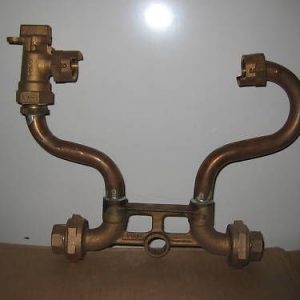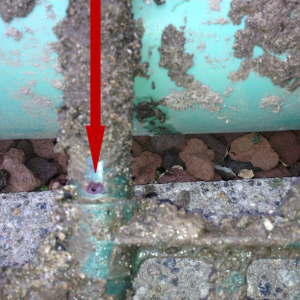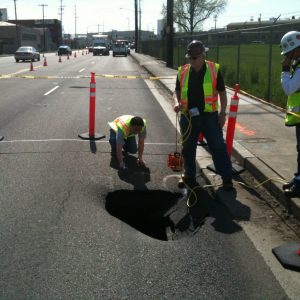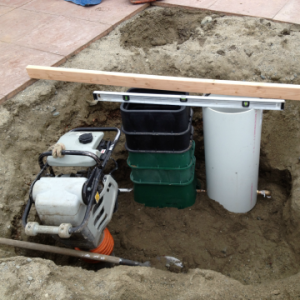 For those of you who own a home, the last thing that you think about is what is happening underground to your utilities. Most of us assume that these systems will last for many years with little or no trouble. Unfortunately, there are instances where certain soils will cause premature failure of some of these components resulting in potentially significant damage.
For those of you who own a home, the last thing that you think about is what is happening underground to your utilities. Most of us assume that these systems will last for many years with little or no trouble. Unfortunately, there are instances where certain soils will cause premature failure of some of these components resulting in potentially significant damage.
As background information to understand the problem, there are several components that make up your water supply system at the meter. Most of us are very familiar with what a water meter is and does. There are, however, other components involved that complete this system so that your home has a steady and constant supply of water. One of the critical elements is the meter setter. It is a double S shaped copper assembly that connects to both the water utilities and your house service lines. The meter installs between the open space at the top of the setter and the fittings on the bottom connect to the water lines on each side. Most of these setters also have internal one way check valves that prevent contaminated water from back-flowing into the public water system in the event that there is a break in your water service on your side of the meter. This is known in the industry as a “closed system”. There are other steps that a homeowner needs to take to protect their homes internal plumbing with a closed system. In my experience with the local homes, many are not properly protected from this future damage.
In some cases in our area, the water meter service lines are extremely deep in the ground and so the serving utility will generally stack a series of these setters or resetters as they are called and connect them to each other until they have the meter at a convenient height for reading and future service. The lowest setters are also typically partially buried in the soils. If soil conditions are correct, these copper assemblies should last many years without problems. However, this has not been the case recently.
 The image to the left represents a recent meter setter that was removed after a 20,000 gallon loss of water was discovered. The aggressive soils over the course of the last 16 years have essentially corroded the copper piping resulting in various pinholes and significant loss of pipe wall thickness. Upon closer inspection, there was very little metal left to prevent a catastrophic failure of this critical device. We also uncovered a pressure reducing valve covered in the same soil that had similar evidence of significant corrosion. A catastrophic failure of any of these devices could have caused a number of property damage issues such as creation of a sink hole under the retaining block walls and adjacent roadway. Depending upon the time of the year and ground conditions, this could also result in a substantial delay in restoration of water service.
The image to the left represents a recent meter setter that was removed after a 20,000 gallon loss of water was discovered. The aggressive soils over the course of the last 16 years have essentially corroded the copper piping resulting in various pinholes and significant loss of pipe wall thickness. Upon closer inspection, there was very little metal left to prevent a catastrophic failure of this critical device. We also uncovered a pressure reducing valve covered in the same soil that had similar evidence of significant corrosion. A catastrophic failure of any of these devices could have caused a number of property damage issues such as creation of a sink hole under the retaining block walls and adjacent roadway. Depending upon the time of the year and ground conditions, this could also result in a substantial delay in restoration of water service.
In discussions with the local water utility, they are somewhat perplexed as to what is causing this corrosion. Copper is generally recognized by knowledgeable  engineers and water utility personnel to not be adversely affected by soils and to be essentially immune to corrosion. There is outstanding history of copper tubing in most underground environments as being a highly corrosion resistant material. The conditions that would contribute to this kind of corrosion are unusually complicated. Some recent independent studies have indicated that elevated concentrations of sulfate or chloride or both in the soil are probably the primary elements in this copper corrosion process. Soils also containing large quantities of organic matter can be corrosive. The utility district is concerned since this is the second instance of the same event occurring in the area within the last 6 months and the evidence is clear that unexpected corrosion is occurring. There is a real concern that there will be more similar events in the future.
engineers and water utility personnel to not be adversely affected by soils and to be essentially immune to corrosion. There is outstanding history of copper tubing in most underground environments as being a highly corrosion resistant material. The conditions that would contribute to this kind of corrosion are unusually complicated. Some recent independent studies have indicated that elevated concentrations of sulfate or chloride or both in the soil are probably the primary elements in this copper corrosion process. Soils also containing large quantities of organic matter can be corrosive. The utility district is concerned since this is the second instance of the same event occurring in the area within the last 6 months and the evidence is clear that unexpected corrosion is occurring. There is a real concern that there will be more similar events in the future.
At this juncture in time, the particular water district does not plan on taking any preventative measures to stop these events. The general consensus seems to be a “wait and repair” approach as these start to fail. Therefore, this requires frequent monitoring and vigilance by homeowners to identify early signs of failure so that the water utility can be notified before substantial damage occurs. In some cases there may not be any warning signs and an immediate and sudden failure could happen. Since most of the damage is occurring underground and out of sight, it is very likely for this to go undetected for weeks or even several months. A minor pinhole in the setter above resulted in a 20,000 gallon loss of water in less than 2 months so a more significant failure could easily become a 200,000+ gallon event. This could cause considerable damage to soils that are supporting driveways, block walls and roadway beds. Sinkholes are examples of what typically occurs when this type of subterranean water erosion occurs. In many instances the sinkhole appears when the weight of vehicles cannot be properly supported by the roadway and the road collapses under the vehicle.
Unoccupied and vacant homes need to be carefully monitored on a frequent basis by someone qualified who will regularly check conditions and report back findings. Generally, the repairs involved require the organized coordination of multiple parties to work together efficiently. In the project above, other components in the water supply system were at risk and appropriate measures were taken to either replace or relocate for easier future maintenance access.
 As part of our HomeWatch program, we routinely check and inspect all water meters. This enables us to quickly identify if problems exist and we immediately take steps to minimize any future damage. We also work closely with the water utility and other local contractors to make sure the work is properly repaired and service is restored. Our years of expertise in the construction industry enables us to also examine other components and offer solid recommendations thereby preventing future problems. As mentioned above, these closed systems also require special expansion control devices to minimize damage to internal house plumbing systems. We have researched and installed several different types of devices that meet code requirements and provide a high level of protection. For more information on how we can assist you, please click on this link.
As part of our HomeWatch program, we routinely check and inspect all water meters. This enables us to quickly identify if problems exist and we immediately take steps to minimize any future damage. We also work closely with the water utility and other local contractors to make sure the work is properly repaired and service is restored. Our years of expertise in the construction industry enables us to also examine other components and offer solid recommendations thereby preventing future problems. As mentioned above, these closed systems also require special expansion control devices to minimize damage to internal house plumbing systems. We have researched and installed several different types of devices that meet code requirements and provide a high level of protection. For more information on how we can assist you, please click on this link.

Recent Comments